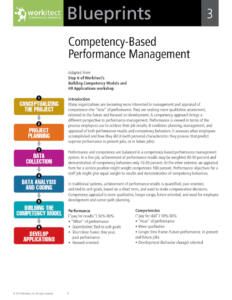Many organizations are becoming more interested in management and appraisal of competence – the “how” of performance. They are seeking more qualitative assessment, oriented to the future and focused on development. A competency approach brings a different perspective to performance management. Performance is viewed in terms of the process employees use to achieve their job results. It combines planning, management, and appraisal of both performance results and competency behaviors. It assesses what employees accomplished and how they did it (with personal characteristics they possess that predict superior performance in present jobs, or in future jobs).
COMPETENCY-BASED PERFORMANCE MANAGEMENT WEB PAGE
Performance and competence are balanced in a competency-based performance management system. In a line job, achievement of performance results may be weighted 90 percent and demonstration of competency behaviors only 10 percent. At the other extreme, an appraisal form for a service position might weight competence 100 percent. Performance objectives for a staff job might give equal weight to results and demonstration of competency behaviors.
In traditional systems, achievement of performance results is quantified, past oriented, and tied to unit goals, based on a short term, and used to make compensation decisions. Competency appraisal is more qualitative, longer range, future oriented, and used for employee devel¬opment and career path planning.
PERFORMANCE (“pay for results”)
50%-90%
• “What” of performance
• Quantitative: Tied to unit goals
• Short time frame: One year, past
performance
• Reward oriented
COMPETENCIES (“pay for skill”)
10%-50%
• “How” of performance
• More qualitative
• Longer time frame: Future
performance in present and future jobs
• Development (behavior change)
oriented
Steps in Developing a Competency-Based System
1. Identify competencies required for superior performance in present or future jobs (competencies needed to implement a desired strategic change).
2. Train managers and employees in performance management (e.g., coaching for performance improvement). Performance coaching involves:
a. Agreement between manager and employee on his or her “actual” levels of competence. An employee’s competency levels are most easily assessed with “360 degree” ratings by colleagues “all around” the employee (i.e., by his or her boss, and a sample of peers, subordi¬nates, and customers who know the employee’s work well). The average of these ratings is compared with the employee’s self-assessment of his or her competencies.
b. The employee identifying the “desired” levels of competence he or she wants to develop to meet his or her own performance or career advancement goals.
c. Agreement on a “contract” between employee and manager on
• The employee’s competency development goals and the action steps he or she will take to attain them
• The help and support the manager will give the employee
This coaching approach uses the principles of “self-directed change” theory, which holds that adults change only when they:
• Feel it is in their own best interests to do so
• Feel dissatisfied with their existing situation or level of performance (“actual”)
• Are clear about a “desired” situation or level of performance
• Are clear about action steps they can take to move from the actual to the desired situation or level of performance
Competency-based performance management systems shift the emphasis of appraisal from organization results achieved to employee behaviors and competencies demonstrated. Diagnosis and problem solving to deal with poor performance takes this form: “If results are not at the desired level, give higher priority to these job tasks, demonstrate these behaviors more often, and develop these competencies” (i.e., model the task priorities, behaviors, and competency levels of the best performers in the job).
The addition of competencies to performance management systems has important implications for management. Managers explicitly commit themselves to provide employees with formal training, coaching, and other competency development activities during the performance period.
The most important factor in implementing a competency-based performance management system is training managers to provide this coaching and developmental assistance. (Studies of effective performance management systems consistently find training to be an important input.) Employee training also helps employees understand how the system works, what their role is, how to assess themselves, and how to contract for competency development activities with their managers. Read about organizational issues. A Blueprint for Competency-Based Performance Management
How Competencies Drive Performance Improvement
Make Performance Management a Positive Experience
Optimize Your Performance Management System
Competency-Based Performance Management to Reward Top Performers
RESOURCES
Writing Goals A programmed instruction booklet that teaches employees at all levels how to write effective job goals. 43 short pages (PDF)
Developing the “Managing Performance” Competency From Workitect’s Competency Development Guide, the premier resource guide for developing thirty-five leadership and professional competencies. 6 pages (PDF)
Performance Planning & Review A handbook for employees that explains their role in the planning and review process. It includes sections on setting job goals, reviewing progress, career development, the annual review, and the correlation to compensation actions. 17 pages (PDF)
Developing the “Managing Performance” Competency From Workitect’s Competency Development Guide, the premier resource guide for developing thirty-five leadership and professional competencies. 6 pages (PDF)
Performance Planning & Review A handbook for employees that explains their role in the planning and review process. It includes sections on setting job goals, reviewing progress, career development, the annual review, and the correlation to compensation actions. 17 pages (PDF)
 To learn more about our products and services, and how competencies and competency models can help your organization, call 800-870-9490,
To learn more about our products and services, and how competencies and competency models can help your organization, call 800-870-9490,
or use the contact form at Workitect.
©️2024, Workitect, Inc.



Leave A Comment